Posted February 28, 2021 by Nicky in Reviews / 0 Comments
 The Address Book, Deirdre Mask
The Address Book, Deirdre Mask
Another book read to review on Postcrossing’s blog eventually! This book delves into the history of addresses: we take them for granted now (especially on Postcrossing, where I spend some time every day verifying people have put their addresses in as a standardised format recognised by the UPU), but they’re a relatively recent innovation — and surprisingly powerful, shaping a number of areas of your life. Access to healthcare, benefits, job opportunities, credit, personhood… and of course, the state’s ability to find you when you’ve done something illegal or discouraged (it’s not all positive!).
Mask digs through examples of the uses of addresses for things like epidemiology (the famous map revealing the cholera outbreak centred on the Broad Street Pump… and the less famous story of the recent cholera outbreaks in Haiti), examples of vanity addresses, and instances where the names of streets reveal our history, biases and politics.
I felt like I learned a lot, when I put this down, but right now it’s hard to summarise, partly because it’s pretty wide-ranging. The recurring theme is identity, though, and it opened my eyes to a lot of things about addresses that I’d never considered in that light.
Rating: 4/5
Tags: book reviews, books, Deirdre Mask, non-fiction
Posted February 27, 2021 by Nicky in Reviews / 2 Comments
 A Cheesemonger’s History of the British Isles, Ned Palmer
A Cheesemonger’s History of the British Isles, Ned Palmer
This one is exactly what it says on the tin: a history of the British Isles which follows the lot of cheese, cheesemakers, affineurs and cheesemongers. It touches on a surprising amount of history, getting further into things that you might expect. Armies march on their stomachs, which are partly full of cheese, for a start.
It isn’t, of course, just pure history: there’s also a lot of speculation, from what ancient cheeses might have tasted like to who might have made them and why, and I wouldn’t exactly cite it as a source for something because it’s chatty and speculative, using experience to pry into parts of history we just can’t see. For example, he mentions at one point that the monks in a monastery can’t have been the ones to make the cheese, because they couldn’t leave the grounds and the herds would have been elsewhere… and you need to start the process right away. He speculates that they probably acted as affineurs, aging and storing the cheeses once made.
I don’t always love history when it’s speculative, but Palmer’s expertise about cheese is obvious — and he gets onto more solid ground with sources to refer to as well, with the later parts of the book. I love eating cheese, but it’s obvious I need to try more different kinds of cheese… and I had no idea of most of the details of how cheese is made, how different cheeses are ripened and different effects are produced. Palmer’s enthusiasm makes all of that interesting, and his book is riveting.
Rating: 5/5
Tags: book reviews, books, history, Ned Palmer, non-fiction
Posted February 24, 2021 by Nicky in Reviews / 0 Comments
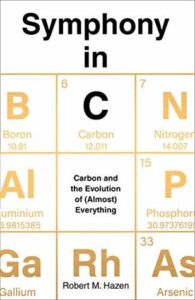 Symphony in C, Robert M. Hazen
Symphony in C, Robert M. Hazen
Honestly, I could’ve picked this up just for the title, which I thought was clever. But of course, carbon is an intensely important element for life, so it ties in very much with my interest in biology — no carbon, no us! — and it didn’t seem like it’d be too far off the random path of my current interests. Which proved to be mostly true: I found it harder going than a book about biology, my preferred science, but Hazen’s enthusiasm for his subject carried me along to a great extent.
Often enthusiasm gives life to writing, but I did find that there were bits of this I got a bit stuck on just through not getting involved enough… and knowing that e.g. Richard Fortey can get me excited about rocks with the way he writes, that I do put down to a certain dryness in the writing. Oddly enough, it was the parts on biology I yawned through; I don’t need the facts to be new to me, but if you’re explaining to me about why carbon is the ideal element for life, I need you to make it more exciting than my textbook. (This may not be fair, as I find certain aspects of my textbooks very exciting. The membrane attack complex is a marvel! No, friends who have been subject to me exclaiming about the MAC — I’m not over it yet! Biology is amazing!)
Anyway, if you’re interested in carbon, in the history of how we understand carbon as well as the current state of the field, it’s not a bad read. It’s lacking in tables and images that can really talk people through the data rather than just explaining like a story, so it’s very pop-science in that sense, so I’m not sure how much of it will stick for me. The symphony conceit got old for me/didn’t always feel like the right way to balance/organise the material, but I learned some new things and cemented some others in my mind, and really, that’s all I ask.
Rating: 3/5
Tags: book reviews, books, non-fiction, Robert M. Hazen, science
Posted February 24, 2021 by Nicky in Reviews / 0 Comments
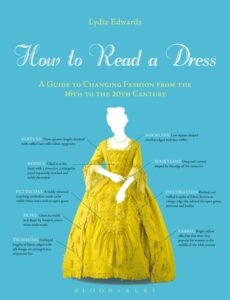 How To Read A Dress, Lydia Edwards
How To Read A Dress, Lydia Edwards
This book is a handy survey of women’s fashion (mostly of dresses, but occasionally including titbits about other aspects of dress and accessorising, like necklaces and shoes) from the 16th to the 20th century. It features full-colour photographs, carefully annotated with useful pointers as to what to notice, and introductory essays explaining the trends of each period.
The annotation is very good, but the introductory paragraphs for each section are a bit less organised. It doesn’t refer to specific examples of dresses in that chapter, but stays totally general… meaning it’s hard for me — a not especially visual person — to link the dresses up with the trends they illustrate. Sometimes I’d look through the dresses for a specific feature, but not really see anything that seemed to match. In addition, sometimes the text would mention a specific photograph or illustration, but it wasn’t next to the text, and there was no helpful “(figure 3)” or anything; instead it would say something like “this photograph of a gentleman…” Which photograph of a gentleman? What page it is on?!
Anyway, I found it really interesting, and useful, with a few flaws. It would probably work better for someone with a visual memory!
Rating: 3/5
Tags: book reviews, books, history, Lydia Edwards, non-fiction
Posted February 7, 2021 by Nicky in Reviews / 0 Comments
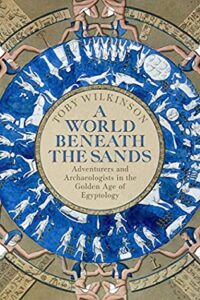 A World Beneath the Sands, Toby Wilkinson
A World Beneath the Sands, Toby Wilkinson
A World Beneath the Sands is a book not about Egyptology, for the most part, but about Egyptologists — and not just the highlights (Champollion, Petrie, Howard Carter) but some of the less-known names as well, including some of the women who facilitated the study of Ancient Egypt. Broadly speaking, it should have been my thing, but in execution, it just… wasn’t. It was rather slow, and just… not very exciting.
It was mostly about political manoeuvring and the various European countries that jockeyed over control of Egypt, and the doing of archaeology a distant second. The details of digs and finds were barely described, mostly just listed off before moving onto the next list of finds.
In principle, a history of the archaeologists, scholars and looters who shaped our understanding of the history of Ancient Egypt really should have been fascinating, but I found it really dry and unnecessarily verbose. I’m hoping it’s just because I didn’t enjoy the topic as much as expected, because I have another of Wilkinson’s books (The Rise and Fall of Ancient Egypt), and I’m hoping to enjoy that a lot!
Rating: 2/5
Tags: book reviews, books, history, non-fiction, Toby Wilkinson
Posted February 7, 2021 by Nicky in Reviews / 0 Comments
 The Biscuit: The History of a Very British Indulgence, Lizzie Collingham
The Biscuit: The History of a Very British Indulgence, Lizzie Collingham
When I mention that I’ve been reading a history of biscuits, people’s usual response is confusion about why that would take a whole book or be particularly interesting. The answer is that Collingham discusses the social, economic and political circumstances surrounding the development of biscuits, and though the subtitle calls it a “British indulgence“, it discusses other countries too and the colonial uses of biscuits (yes, really — they were thought to be useful in ‘civilising’ places like India).
This was exactly what I was hoping for: a microhistory on a really narrow topic that used that topic to reflect on larger issues. You might not automatically think of looking at the Industrial Revolution through the role of biscuits, or realise the extent to which naval voyages of exploration relied on ship’s biscuit, or appreciate the fact that the original biscuits were twice-baked bread made a couple of times a year in communities that couldn’t afford to bake fresh bread every day… but all those different topics can open out when you start digging in.
You don’t just get to learn about when they started making Jammie Dodgers, or that the company was notoriously cheapskate and used plums for the “raspberry” jam in them because it was cheaper than raspberries… that’s certainly one of the things I learned, but I also learned that the custom of following savoury food with a sweet dessert has come down in a very long tradition from when the stomach was thought to putrefy food, and Arab ideas that sugar was ideal to help seal off the stomach from harmful vapours caused by that process.
In the end, it’s a history of biscuits and it comes back to that pretty swiftly when it strays away, but using the biscuit as a home base, it can tell you an awful lot.
In addition, it also contains some recipes between chapters, some of them traditional and others from modern sources. I haven’t tried any, since I’m not the baker of the family and I’m also very lazy, but it’s a nice touch and we’ll probably keep my copy in order to give them a try someday.
Rating: 4/5
Tags: book reviews, books, history, Lizzie Collingham, non-fiction
Posted February 6, 2021 by Nicky in Reviews / 2 Comments
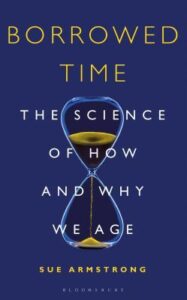 Borrowed Time: The Science of How and Why We Age, Sue Armstrong
Borrowed Time: The Science of How and Why We Age, Sue Armstrong
I’ve read one of Sue Armstrong’s books before, on the role of the p53 gene in cancer, so despite aging and the science thereof not really being my thing, I thought I’d give it a try. And it was, in fact, riveting. I knew a little about some of the experiments — I read a paper on sirtuins and resveratrol for my final exam of my BSc, so that gave me some extra context — but much of the detail was new to me, and Armstrong explains things beautifully and keeps things very clear.
The answer to the question of how and why we age is, of course, “lots of ways and lots of reasons”, and the science isn’t all the way yet on understanding exact mechanisms and unpicking the many small effects that can add up over a lifetime. Armstrong avoids giving any false certainty, but makes it clear how people in the know expect things to go, and what they’re cautious about. Unlike some writers, she doesn’t intrude a lot into the narrative (we don’t have to hear stories about her neighbour’s sister’s dog’s brother, which some science writers lean on a bit too heavily), or when she does it feels relevant and useful to understand where she stands.
For a field with so many different puzzle-pieces, Armstrong really brings it together well, and I actually found myself reading this all in one day, in great big chunks. Now that’s good science writing!
Rating: 4/5
Tags: book reviews, books, non-fiction, science, Sue Armstrong
Posted February 6, 2021 by Nicky in Reviews / 0 Comments
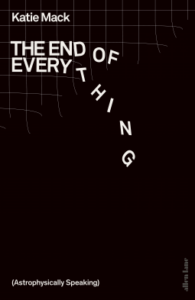 The End of Everything, Katie Mack
The End of Everything, Katie Mack
The End of Everything is about all the potential ways the universe can end. Katie Mack describes the various scenarios and why they’re likely or unlikely, the evidence for them, and what looking into these possibilities can teach us about the universe, even if they all turn out to be wrong. She has a fairly breezy style, but some of the actual physics is pretty hard to understand, so it’s to her credit that it feels comparatively light while also making what she describes clear enough.
Unfortunately, for me, physics is one of those topics that I don’t dislike because it’s hard — though I do find it to be difficult — as because it leaves me very much wondering what the point of everything is. Even biology will leave me feeling that way once I dig too deep, and this isn’t a dig at Mack at all… but it definitely made it harder for me to enjoy this book, because it does deal with those really big topics, and where some people can take joy in all the unknowns and the deep weirdness that we manage to exist at all, it really gets under my skin and makes me feel very small and pointless. I can’t really recommend that as an experience, but if entropy doesn’t get you down and a cold empty universe doesn’t bother you, then this will be much more to your taste!
Rating: 3/5
Tags: book reviews, books, Katie Mack, non-fiction, science
Posted February 4, 2021 by Nicky in Reviews / 0 Comments
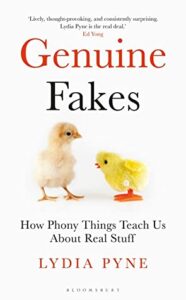 Genuine Fakes: How Phony Things Teach Us About Real Stuff, Lynda Pyne
Genuine Fakes: How Phony Things Teach Us About Real Stuff, Lynda Pyne
I didn’t really expect this book to be so riveting, but it really was. The central idea is a bit shaky, because Lynda Pyne’s definition of “genuine fakes” is very, very elastic: one example is lab-created diamonds, another is the Spanish Forger’s faked medieval illustrations, another is the faked Archaeoraptor fossil… The things that make each item “genuine” or “fake” are pretty flexible. The reasoning is most solid when it comes to art like the Spanish Forger’s work, which has now become desirable in and of itself. The reasoning for the Archaeoraptor fossil is basically “well, it’s made up of real fossils!” Yeah, who cares, those fossils have been ripped from their original correct context in a desperate attempt to deceive people and get more money. That’s not a genuine fake, that’s just a fake.
And then there’s a bit about wildlife documentaries and how they’re kind of fake (sometimes, depending on how they’re filmed) and kind of not, and the point kind of dissipated somewhere in there for a while in favour of just explaining how much money it takes to create a documentary like Blue Planet II.
That all said, though, even if Pyne’s examples don’t all hang together, I enjoyed her dissection of each item and the things it has to tell us. I didn’t know anything about the Spanish Forger before, and that was maybe my favourite thing to learn about. Interesting stuff here, just… not really very organised.
Rating: 3/5
Tags: book reviews, books, history, Lynda Pyne, non-fiction, science
Posted January 23, 2021 by Nicky in Reviews / 0 Comments
 A History of the Paper Pattern Industry, Joy Spanabel Emery
A History of the Paper Pattern Industry, Joy Spanabel Emery
I don’t think this book would be of great interest to someone who isn’t interested in sewing at all, but you don’t have to actually sew to take an interest — a couple of episodes of the Great British Sewing Bee should set you up with all you need to know for background, if you feel you need to know a little more. Mostly, what you need to know is explained in the text, as the history goes through the development of early patterns from “rock of eye” to printed patterns showing various different sizes.
It seems that paper patterns have a surprising amount to tell fashion history: although paper patterns for home sewers were behind the fashion by a little, they couldn’t be that far behind or they’d be pointless, so they did follow fashion and sometimes inform it (for instance, in the length of mini-skirts). Patterns have survived well, despite the flimsy paper, because the paper was acid-free, and often systems of notches and punched holes were used instead of ink. Carefully unfolded, very old patterns are still useable and useful.
It’s surprising to me that the companies which established themselves early in the history of providing patterns for home sewers still exist! It was a little odd to meet their names back before printed patterns became possible, for instance.
The book is richly illustrated with images of the fashions and pattern-packets discussed, showing the trends through time very visually as pattern companies started putting the pattern pieces in envelopes, providing more instruction, and expanding their ranges to tempt younger sewers into following fashions. It also comes with some vintage patterns, which make no sense to me, but might interest people with a less academic interest in sewing and actually making garments.
Rating: 4/5
Tags: book reviews, books, history, Joy Spanabel Emery, non-fiction
 The Address Book, Deirdre Mask
The Address Book, Deirdre Mask








